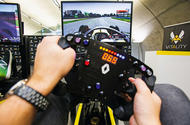E-sports
With the motorsport season on hold, e-sports racing is filling the void. We gave the spectacle a try
The shutdown of motorsport is hardly the most serious consequence of the coronavirus outbreak – but it has denied people of a welcome dose of escapism and distraction at a time they need it most.
Vast swathes of my weekends are often spent watching all varieties of racing and rallying. Now, its absence has left a big void, particularly while we should all be following advice and staying at home.
But there is something to fill that void: virtual motorsport. Leading e-sports companies and major motorsport promoters have been rapidly organising online events, featuring a fascinating mix of ‘real-world’ racing drivers and e-sports stars. So can simulated racing replace the real thing?
To find out, I gave it a try last weekend. My viewing included the official Formula 1 Virtual Grand Prix, shown live on Sky Sports F1 in the UK and, like the regular F1 e-sports championship, using the Codemasters F1 2019 game. I also watched action from the eNASCAR iRacing Pro Invitational Series event (shown on TV channel Fox Sports 1 in the US), and Veloce Esports The Race All-Star E-Sports Battle (streamed live on YouTube).
The first takeaway is that watching professional e-sports racing isn’t like watching your friends play console games. The graphics are amazingly realistic, and the production values high. At times you could easily mistake it for the real thing. Better yet, there were no annoying cutaways to random celebrities standing in the pits.
It helped that all three events featured real-world commentators. Notably, BBC Radio Five Live F1 commentator Jack Phillips called both the Veloce Esports event – aided admirably by ex-F1 racer Jolyon Palmer – and the official F1 event.
Meanwhile, the eNASCAR race was covered by Fox’s Mike Joy and four-time champion Jeff Gordon. It all added hugely to the authenticity, and all did a great job explaining the similarities and differences between real and virtual racing. (Special bonus marks went to the eNASCAR broadcast, which featured all the regular pre-race ceremony, including someone singing the US national anthem in their garage…)
That’s not to say the feeds were perfect. Incidents were missed in all the events, some of the ‘camera’ angles limited views and the delay in (and frequent lack of ) replays of key moments often left you uncertain exactly what was happening. And, frankly, watching virtual cars just doesn’t have the same visceral thrill. It misses the joy of watching a cutting-edge machine being pushed to the limit of its performance.
The other major problems were the jarring moments that snapped you out of any sense of reality. Cars continued on after what would be massive race-stopping shunts, and virtual NASCAR pit stops didn’t feature virtual pit crews. And, worst of all were the various connection issues. In all three events, drivers would occasionally disappear when they lost the connection to the game server.
The worst hit was the F1 event, which was delayed by nearly 30 minutes – and eventually halved in length – due to technical issues. When it started McLaren driver Lando Norris was unable to join, with his car computer-controlled for much of the race (or ‘Landobot’, as he called it). Notably, Landobot held its own and when the real Norris rejoined it was as part of a fun late-race scrap for fourth with YouTube racing star Jimmy Broadbent – that ended with a contentious final lap clash.
Generally, the quality of racing was pretty high, though. Renault’s Guanyu Zhou won the F1 race comfortably, but did have to battle past Red Bull’s Philipp Eng, who started on pole. In the eNASCAR race Denny Hamlin edged Dale Earnhardt Jr in a genuinely thrilling final-lap battle.
The high-profile driver line-ups helped, too. All three events featured a number of real-world drivers (while the F1 event also bizarrely featured golfer Ian Poulter and singer Liam Payne…), giving recognisable stars to root for.
That said, because many were racing remotely, the star names weren’t actually seen or heard from on the broadcasts, except in some slightly stilted post-race interviews. To get their viewpoint, you had to look at social media – where many were streaming their in-car feeds and the likes of Norris provided numerous updates. That’s a major difference: drivers don’t usually have time to tweet during races…
Ultimately, I don’t think e-sports will replace real motorsport soon. You can simulate the cars and racing, but you just can’t capture the drama, vibrancy and feel you get from watching real cars racing. But, at a time when watching real motorsport isn’t an option, e-sports does make a pretty decent alternative.
READ MORE
How to win an F1 race without leaving your home
Source: Autocar
